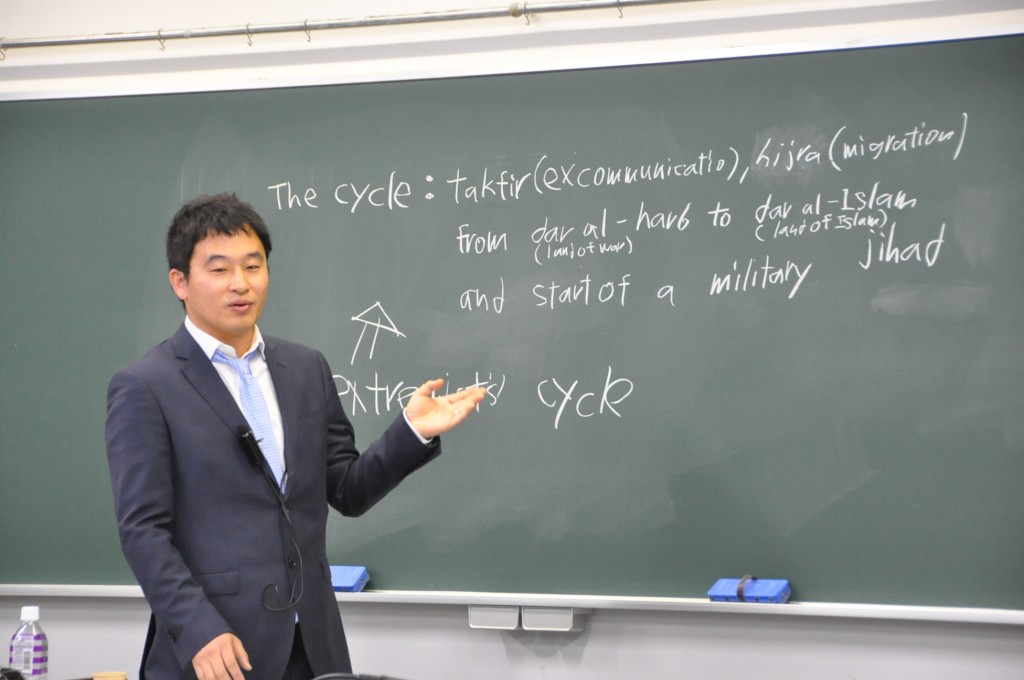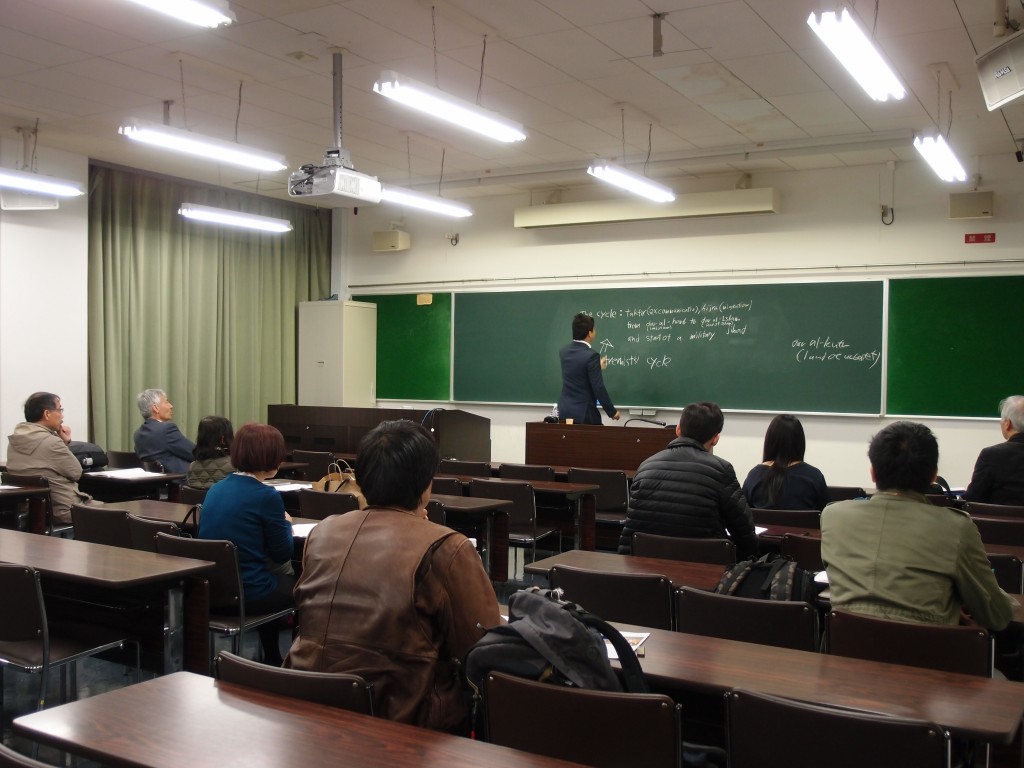Center for Interdisciplinary Study of Monotheistic Religions(CISMOR)Doshisha University
> Public Lectures > 【For Students and Academics】Modern Extremist Groups and the Division of the World: A Critique from an Islamic PerspectivePublic Lectures
13th CISMOR Seminar
【For Students and Academics】Modern Extremist Groups and the Division of the World: A Critique from an Islamic Perspective
| Date: |
2017/11/16 15:00-16:30 |
|---|---|
| Place: | Room S33, Shisei-kan, Imadegawa Campus, Doshisha university |
| Lecture: | Dr. Masaki Nagata |
| Summary: | |
|
This seminar by Dr Nagata discussed a number of progressive stages frequently taken by extremists, from issuing takfir (excommunication) through calling for hijra (from dar al-harb or kufr to dar al-Islam) and ultimately to the launching of a military jihad. The key point made was that religious dogmas in Islam are being misinterpreted, and that these misinterpretations are one of the reasons for the growth of extremist groups and their recruitment of fighters from around the world. The seminar was partially based on an Arab Law Quarterly paper by Professor Mohamed Badar (Northumbria University, UK) and Dr Nagata entitled “Modern Extremist Groups and the Division of the World: A Critique from an Islamic Perspective”.1 Professor Badar was formerly a Chief Judge in the Egyptian Ministry of Justice, and has also worked as an international expert for the United Nations Interregional Crime and Justice Research Institute (UNICRI). The process of extremist escalation typically begins with radical groups criticising a ruler or regime, and then making declarations of apostasy and of excommunication (takfir). They often then go on to argue that a particular land has changed from being dar al-Islam (land of Islam) to being dar al-harb (land of war) or dar al-kufr (land of unbelief), and so they call for Muslims to undertake a migration, or hijra, back to a land of Islam. Finally they launch a military jihad, a war in the name of God, in order to forcefully return the land to dar al-Islam. The most high-profile recent case is that of Dae’sh (also known as Islamic State of Iraq and Syria), who consider hijra to be a test for those Muslims living in dar al-kufr.2 Citing the words of mediaeval jurists,3 they continually reiterate their belief that hijra is an obligation for all Muslims living in dar al-kufr (i.e. land not ruled by Dae’sh), wherever in the world that may be. They argue that those who carry out the hijra are making a clear and public statement of their faith. Firstly, Dr Nagata discussed the Islamic concept of hijra and how its meaning and use have evolved through Islamic history. Hijra was originally simply an escape from religious persecution. The Prophet ordered these migrations for reasons of safety and security, not because dar al-Islam had become dar al-harb, which is how Dae’sh are using them; they have issued calls for hijra simply in order to recruit warriors for their military jihad. There were actually two hijras in the Prophet’s era, and they were of different types. The first was to Abyssinia in 615 CE; this was an attempt to escape from persecution and was merely a recommendation, and furthermore was not a migration to an abode of Islam. The second type was the hijra from Mecca to Medina; this was also an attempt to escape from persecution and establish a new Islamic community (ummah), but unlike the first migration this hijra was obligatory. The aim was to leave behind all pre-Islamic or Meccan ties and beliefs; these had often been based on tribal or familial links, whereas all new relationships were to be based on Islam.4 The term hijra was therefore used by the Prophet to refer to his followers’ attempts to escape from persecution and establish a new Islamic society. The second theme discussed by Dr Nagata was the Islamic division of the world into dar al-Islam and dar al-harb. Islam traditionally considers any territory not under Shari’a rule to be dar al-harb but this division of the world is not itself based on Shari’a. Indeed, neither the Qur’an nor Sunna mention the terms dar al-Islam and dar al-harb. This partition is an entirely man-made concept with no legal basis, and was created after the Prophet’s time by mediaeval scholars who divided the world between two abodes. This separation was informed by the almost permanent state of war during the period. Dar al-harb was the abode of their enemies, the non-believers; it was forbidden land. The next topic of discussion in the seminar was the military jihads being waged by modern extremist groups and, more specifically, how Islam does not recognise them. Such groups typically start a jihad in order to change a land from dar al-harb to dar al-Islam; indeed, jihad is commonly translated into English as ‘holy war’. However, the jihad of the Qur’an is spiritual, not military; both the Qur’an and Sunna view jihad as a struggle on behalf of God and as a religious duty for all Muslims.5 Although certain scholars and groups have relied on Shari’a when making their calls for military jihad, there is actually no basis in Shari’a for such campaigns; the understanding of jihad as being military is a man-made one, again developed by mediaeval scholars who combined qital (fighting) with jihad (spiritual war) and thus created “a new form of jihad by the sword.” 6 The seminar then examined how takfir (excommunication), which is not recognised in the Qur’an, is almost always the starting point for the escalation of extremism. The term and concept of takfir was developed in the 7th century CE by the Khawarij sect, shortly after the Prophet’s time. The Khawarij saw themselves as the only true Muslims - all others were unbelievers. They judged religious sin to be evidence of apostasy, and called for the excommunication of sinners. Thus were the first takfir issued, a device which has been used by extremist groups and scholars throughout the whole of subsequent Islamic history. As with the Khawarij, in the contemporary era Dae’sh also see themselves as the only true Muslims. They have arbitrarily declared certain rulers non-Muslim on the basis that their countries are governed by a combination of Shari’a and man-made laws, as opposed to by Shari’a alone. In fact, takfir has no legal basis in Shari’a and is actually prohibited by it. Furthermore, even though the Qur’an does not explicitly mention the term takfir, its position is clear: human beings do not have the right to excommunicate others, and calling another Muslim ‘kafir’ (unbeliever) is prohibited: “Only God holds the right to decide whether one is a believer or not, and this decision can be made only in the hereafter.” 7 The seminar thus examined the misinterpretation of various Islamic dogmas and concepts. Dr Nagata concluded the seminar by arguing that, as it is the first step, ending takfir is crucial in stopping any progression through to jihad, and therefore in combatting contemporary Muslim extremism itself. ------------------------------------------------- 1 Masaki Nagata and Mohamed Badar, “Modern Extremist Groups and the Division of the World: A Critique from an Islamic Perspective”, Arab Law Quarterly vol. 31, issue 4 (2017):305-335. 2 ‘The Murtadd Brotherhood’ (Dabiq, issue 14, 2016) 19. 3 ‘The Law of Allah or the Law of Men’ (Dabiq, issue 10, 2015) 52. 4 Nagata and Badar, supra note 1, at 312. 5 Ibid., p.313. 6 Ibid., p.307. 7 Masaki Nagata, Mohamed Badar and Tiphanie Tueni, “The Radical Application of the Islamist Concept of Takfir”, Arab Law Quarterly vol. 31, issue 2 (2017):134-162, at 139. |
|
|
*The seminar series is open for students and academics. *Lecuter in English. |
|
|
20171116poster |
|

